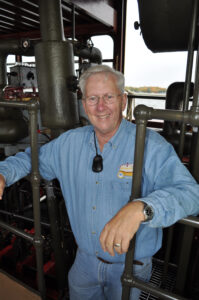By Fred Fey
An Engineer’s day aboard the steamboat Minnehaha begins about an hour before the rest of the crew even shows up. After checking the condition of the engine, boiler, and bilges, he reads the log book for any problems from the last run. Then he starts following a checklist. The first thing on the list is to position various valves necessary for operation and to start the diesel generator which supplies electricity. He then checks fuel and water levels and makes notations on the log sheet. After making sure the boiler water is at the right level, he switches the boiler to the low fire position to warm the system up. The boiler is a Cleaver-Brooks oil-fired package boiler that provides the engine with 180 pounds of steam. While the boiler is coming up to operating pressure, he will add makeup water to storage tanks and begin oiling the engine.
When the boiler pressure reaches about 90 PSI, a boiler water sample is analyzed and, if necessary, chemicals are added to protect against corrosion and deposits which could affect heat transfer. When pressure reaches about 150 PSI, it is time to begin warming the engine. The boiler’s steam isolation valves are opened and steam is allowed to flow into the engine. The engine is in neutral at this point and steam condenses as it warms the cold engine. The engine’s cylinder drains are then opened to allow the condensate to drain to the condenser. The engine is a “triple-expansion condensing steam engine,” which means the steam expands as it travels from a high pressure piston to an intermediate piston, and then to a low pressure piston. Each piston is larger than the one before it. The exhaust steam is then directed from the third cylinder to a condenser. The condenser contains tubes which are cooled by lake water to condense the spent steam, which is then pumped back to the boiler to be reheated to 180 PSI.
As the engine warms and boiler pressure continues to increase, the Engineer will continue oiling while keeping an eye on water levels, pressures, and temperatures. By this time the remainder of the crew (the Captain and one or two Pursers) will have arrived and begun performing their tasks in preparation for departure. After the engine has warmed for half an hour, the engine can be rotated at a low RPM to complete engine warming until the Captain calls for departure. Note that the engine is directly coupled to the propeller shaft – there is no clutch or gear box.
Once underway the Engineer’s job shifts to operating the engine speed and direction according to the Captain’s commands. The Captain has no direct control of the engine – he merely issues commands to the Engineer by sounding a bell signal. The bell signals indicate whether the Captain wants to go ahead or astern and how many RPMs he wants. To shift from ahead to astern, the Engineer must move a lever which causes the engine to reverse rotation and thus reverse the propeller. The boiler maintains proper water level and pressure by starting and stopping burners and water pumps controlled by automatic sensors. However, the Engineer keeps an eye on pressures, water levels, oil levels, et cetera, and takes any actions necessary. Occasionally a water level sensor will stick or a pump will stop pumping, and the Engineer must take corrective action.
Minnehaha has approximately ten volunteer Engineers that are required to be licensed by the State of Minnesota. In order to obtain a Boiler Operator’s license, an applicant must have a required amount of training and operating experience under supervision of a licensed Engineer. If he passes a test conducted by the State and is approved by the MLM’s Engineering Committee, he may operate the Minnehaha propulsion system. If interested in simply helping to maintain the boat, a license is not required.


